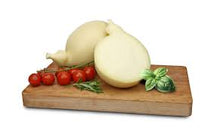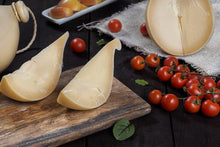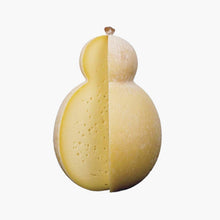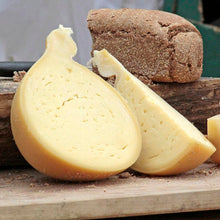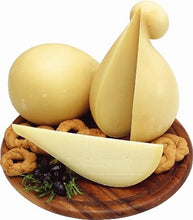
LOCAL PICKUP ONLY !!!!
Caciocavallo is a food belonging to the whole milk and derivatives; more precisely, it is a non- dairy cheese (because it contains little lactose). It is a source of high biological value proteins, calcium, phosphorus and riboflavin (vitamin B2). Caciocavallo belongs to the second fundamental group of foods. From a product and food technical point of view, caciocavallo has the following characteristics:
-
This italian cheese is typical of the southern regions (ex Kingdom of the Two Sicilies: Sicily, Calabria, Campania, Abruzzo, Molise, Basilicata and Puglia). It is also produced in Sardinia.
-
It is made from cow's milk fat (race Podolica), enriched with rennet of lamb/goat, salt and possibly lactic ferments.
-
Seasoned.
-
It can be sprinkled with paraffin as an insulator/protection.
-
It enjoys the recognition of Traditional Italian Agri-Food Product (PAT). That of Silano (Caciocavallo di Silano) obtained the DOP mark.
-
The name caciocavallo could have different etymological origins. It is probably due to the curing/drying method which involves the tying of two shapes in a single rope, subsequently placed "astride" a beam. Another hypothesis is the marking on the form that represents a horse, typical of the Kingdom of Naples. A final theory hypothesizes that caciocavallo, curdled in the fields during transhumances, was then hung on the backs of horses during the journey.
-
There are as many types of caciocavallo as there are production areas. Some variants are also smoked.
Nutritional characteristics of Caciocavallo La Sorresina Cheese
As anticipated, caciocavallo falls into the fundamental group of foods called "Milk and Derivatives" (Group II); as such, it is characterized by its richness in high biological value proteins, calcium, phosphorus and vitamin B2 (Riboflavin).
In caciocavallo, fats, proteins, and water are present in almost equal amounts (31g + 37.7g + 30g).
Caciocavallo has a very high energy intake, mainly supplied by lipids, followed by peptides and finally by glucides (not very significant).
Fatty acids are mainly saturated, proteins contain a pool of essential amino acids complete and similar to the peptides, and carbohydrates made up of lactose disaccharide.
Caciocavallo brings significant quantities of cholesterol but does not show traces of fiber.
Among the vitamins, the concentrations of riboflavin (vitamin B2) and vitamin A (equivalent retinol) stand out.
Concerning mineral salts, there are high quantities of sodium, calcium, phosphorus, and zinc.
The Caciocavallo is, therefore, a semi-hard cheese made of a spun paste produced with cow's milk. Its rind is thin, smooth, yellow. Depending on the seasoning, its aromatic characteristics can vary from sweet to spicy.
In summary, the nutrional characteristic is a follows:
|
Edible part |
100.0% |
|
Water |
30,0g |
|
Protein |
37,7g |
|
Carbohydrates |
2.3g |
|
Starch |
0.0g |
|
Soluble sugars |
2.3g |
|
Dietary fiber |
0.0g |
|
Soluble fiber |
0.0g |
|
Insoluble fiber |
0.0g |
|
Power |
439,0kcal |
|
Sodium |
-mg |
|
Potassium |
-mg |
|
Iron |
0.3mg |
|
Football |
860,0mg |
|
Phosphorus |
590,0mg |
|
Thiamine |
0.01mg |
|
Riboflavin |
0,45mg |
|
Niacin |
0,0mg |
|
Vitamin A |
420,0μg |
|
Vitamin E |
0,43mg |
This cheese accompanies many traditional southern dishes, from appetizers and in some cases to desserts.
Caciocavallo La Sorresina: uses and combinations to best use it in the kitchen
Caciocavallo La Sorresina is ideal accompanied with bread made with mother yeast and cooked in a wood oven. It also adapts very well to different cooking techniques, it is no coincidence that it is the main ingredient of many southern recipes.
It can be used in eggplant parmigiana, in Calabrian baked pasta, but also as a condiment for pasta and even in a grilled version, as is done for tomini. You can eat it together with the soppressata di Calabria DOP, creating a beautiful bond between the body of the salami and the doughiness of the cheese.
Generally, it is used in appetizers from all over southern Italy, both cut with a knife and slicer combined with sweet and sour Tropea onions and local salami. The maximum expression of taste is eaten fresh with a homemade bread bruschetta and fresh broad beans.
As for the former, its use in the form of fondue should be noted, the best recipe is represented by the filej with sausage sauce with the caciocavallo fondue. Another combination is that of spaghetti alla chitarra with carbo- ' nduja, a revisited version of the classic carbonara with the addition of' nduja and grated caciocavallo.
In the second course, it can be used in pork rolls with sauce or in the form of accompanying mousse in creative cuisine. Sporadically it is also found in some Italian desserts in addition to the classic service of the tasting plate of various cheeses.
Caciocavallo, which means "cheese on horseback", gets its name from the manner in which the cheese is always tied together in a rope and dangled over a wooden board to drain and age. An Italian type of pasta filata cheese made out of sheep's or cow's milk, it is produced throughout Southern Italy and the Balkans. The history of Caciocavallo goes back to 500 BC when Hippocrates first mentioned the cleverness of the Greeks in making it.
4 pound (1.8 kilogram) - WEIGHT APPROXIMATES
Ingredients: Pasteurized cow's milk, salt, rennet
Packaging: Vacuumed-sealed plastic
Flavor: Salty, sharp, spicy, tangy
Texture: Semi-soft, stringy
Color: Off-white
Aroma: Earthy, strong
Vegetarian: No
Region: Pasta Filata
Product of Italy







